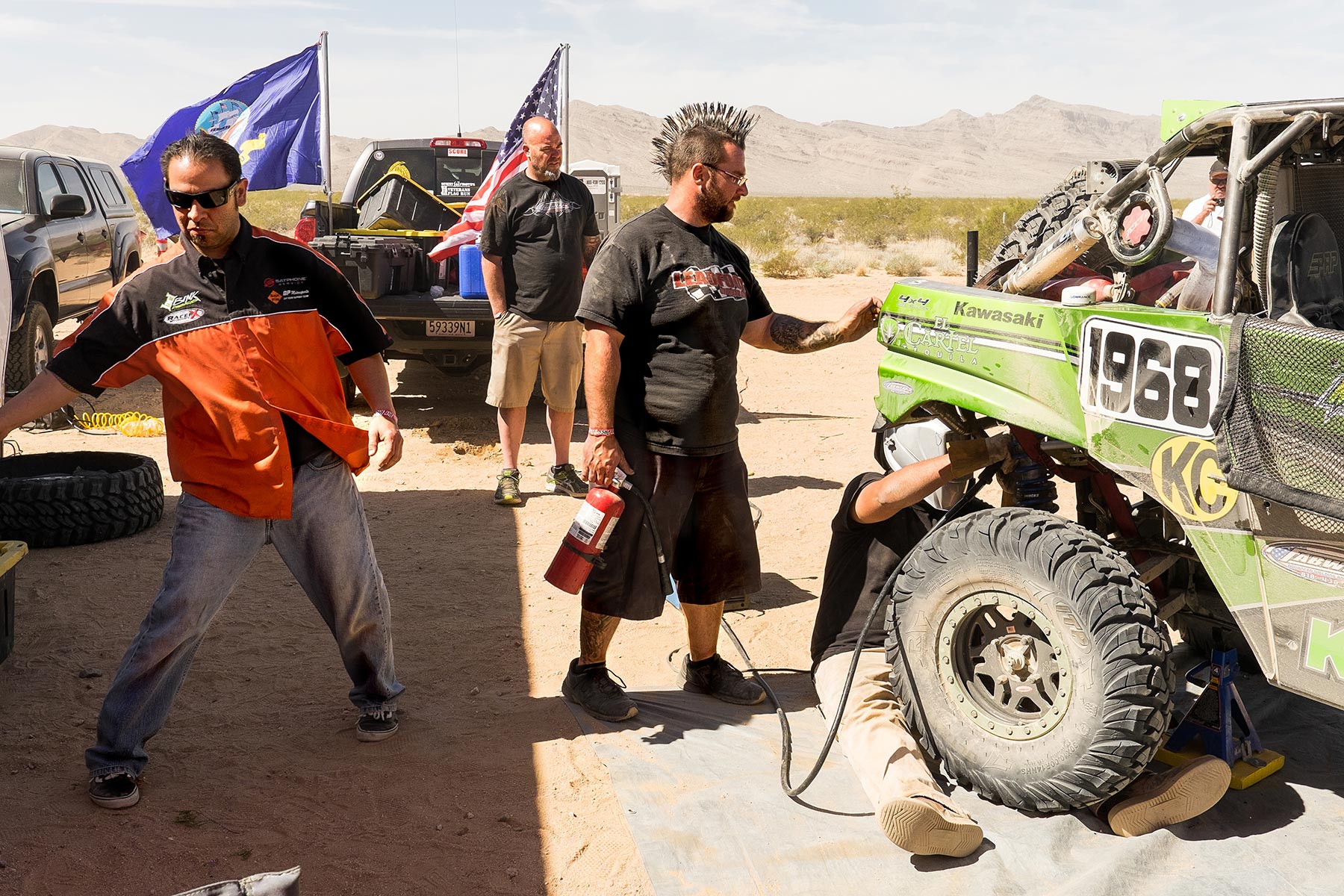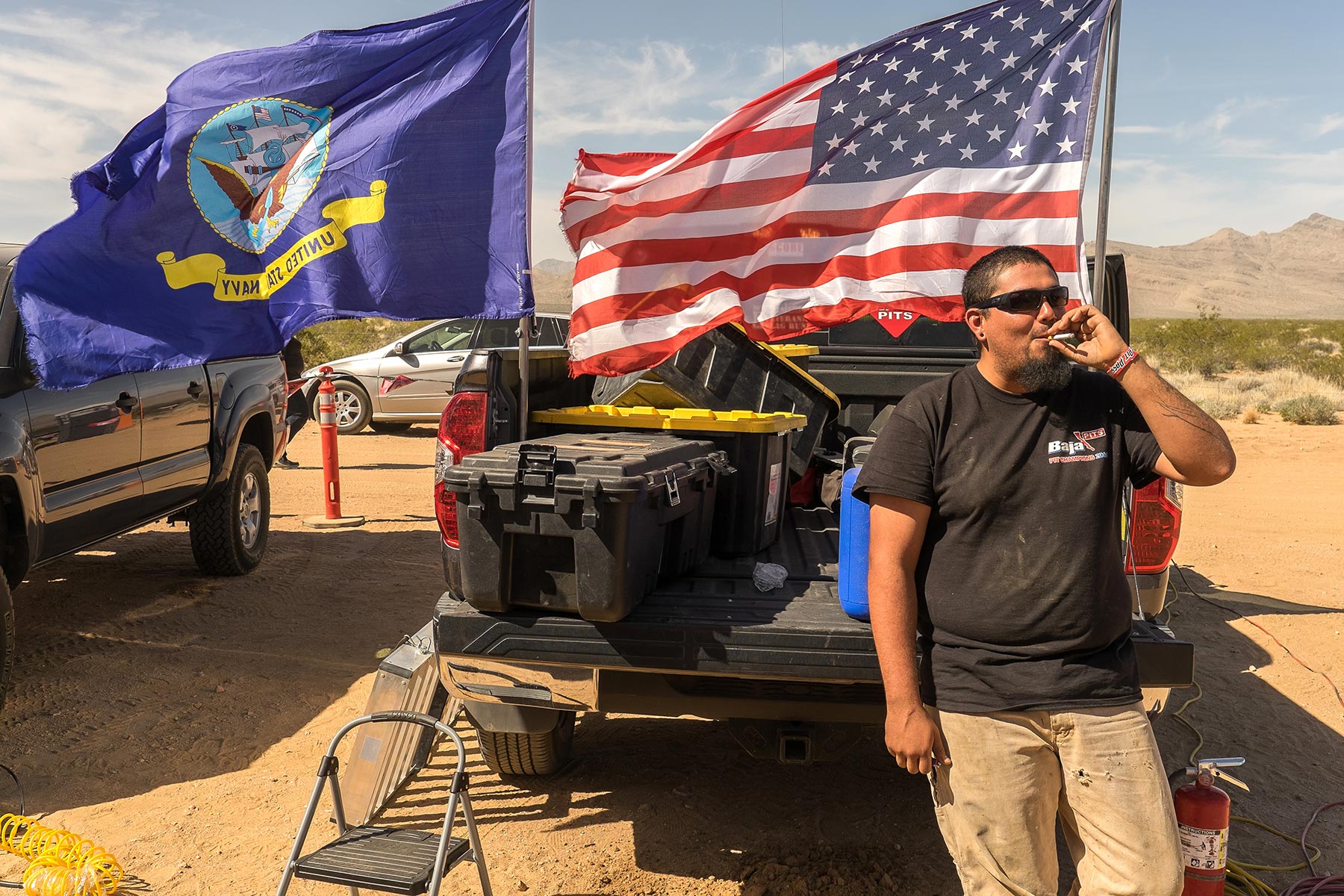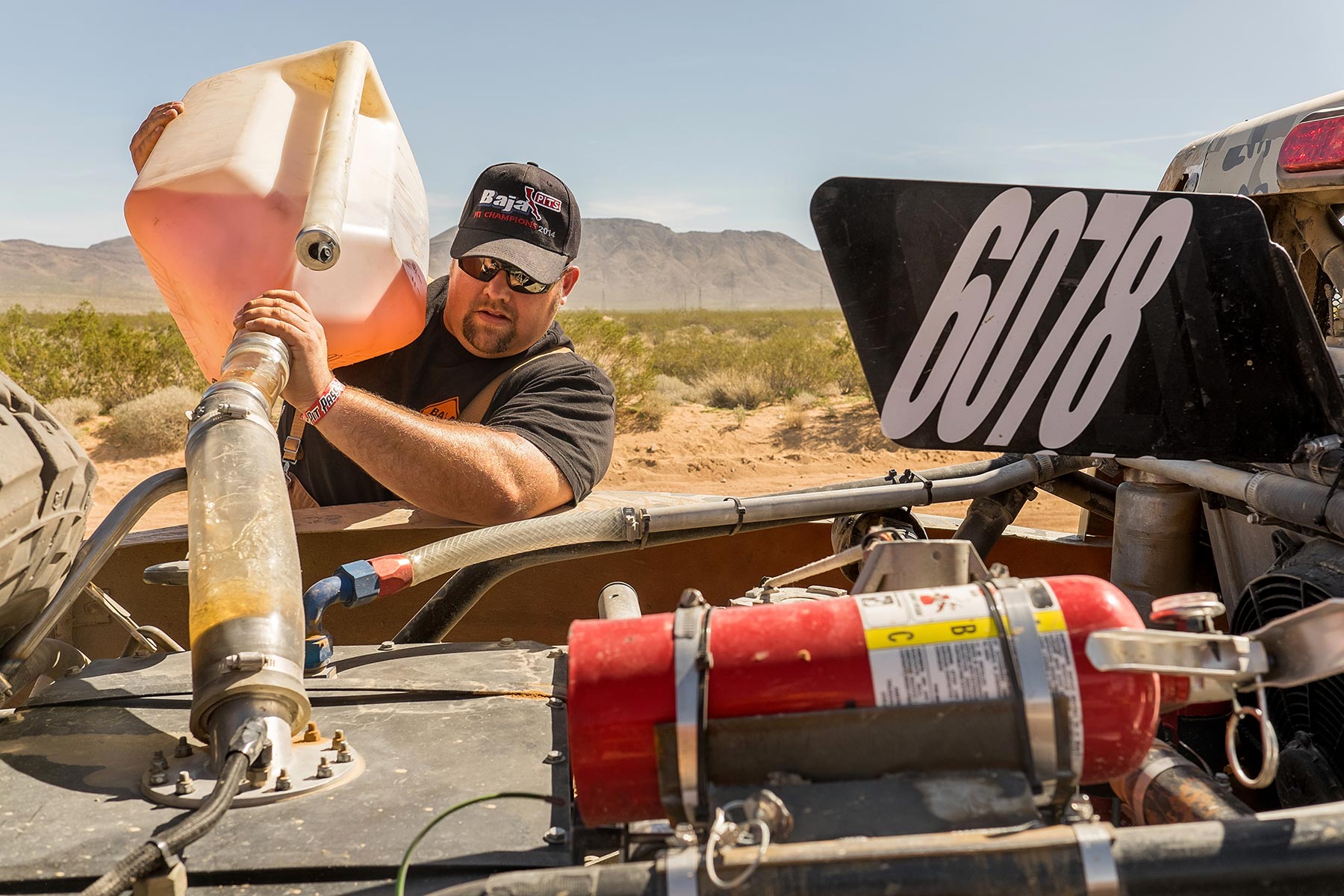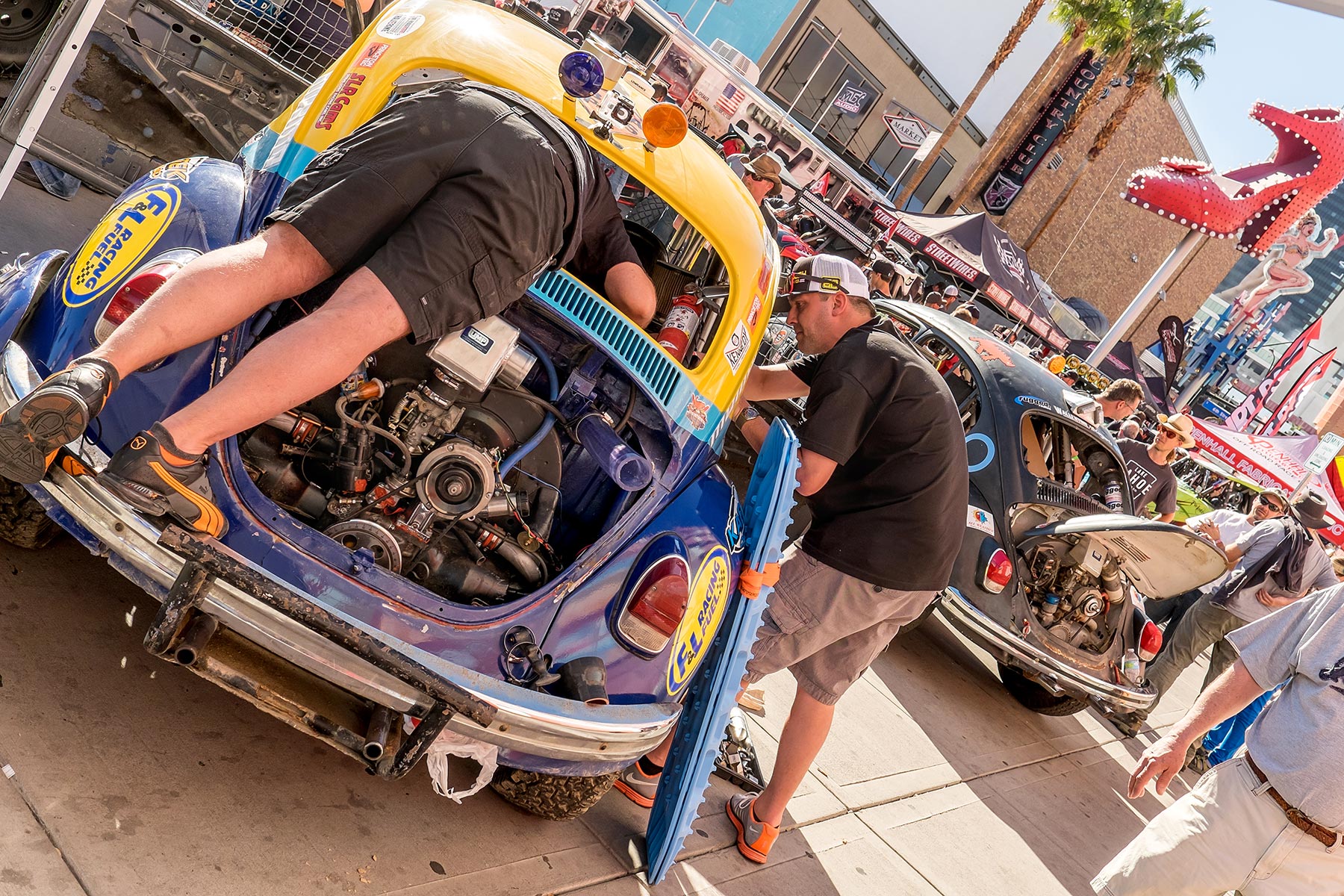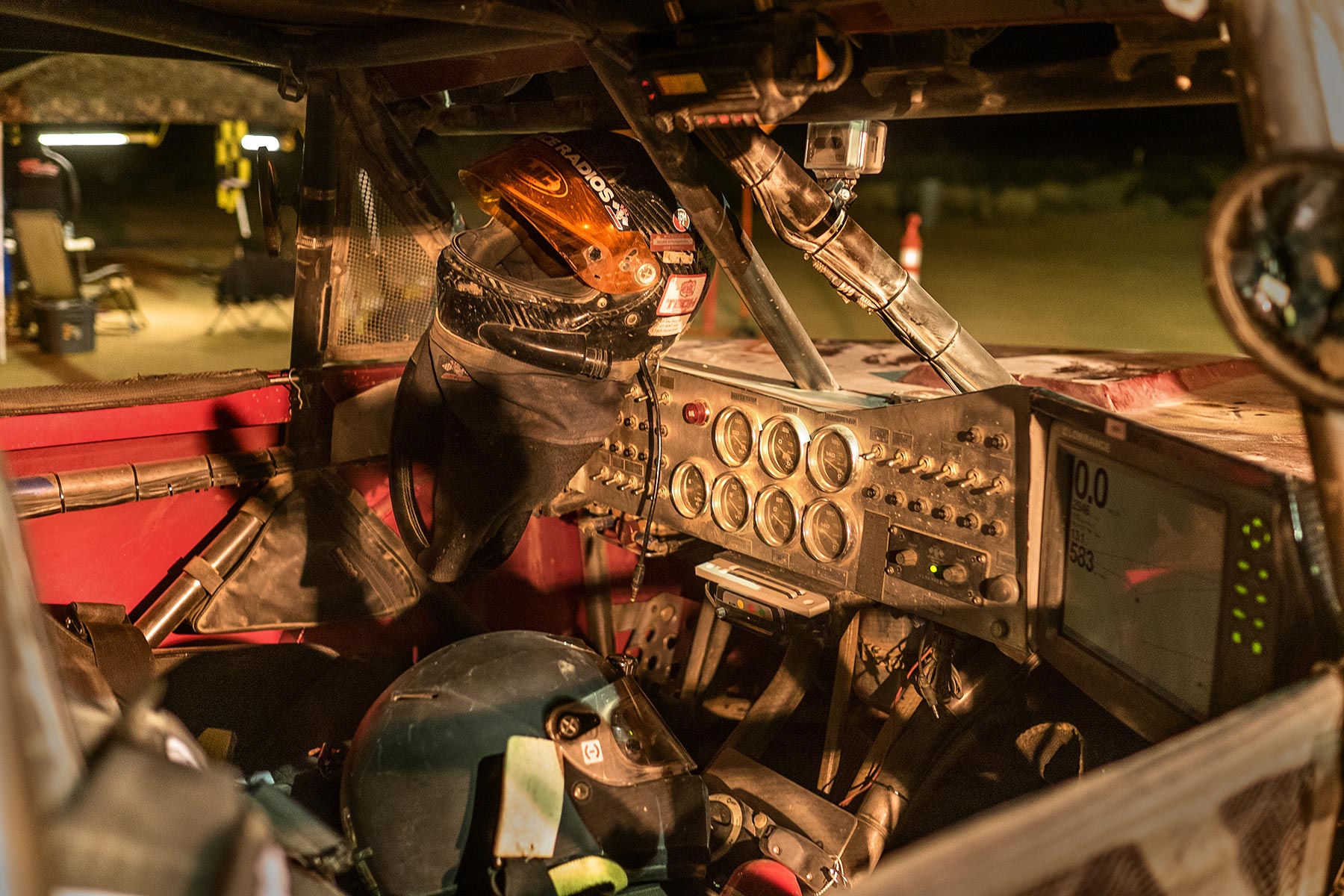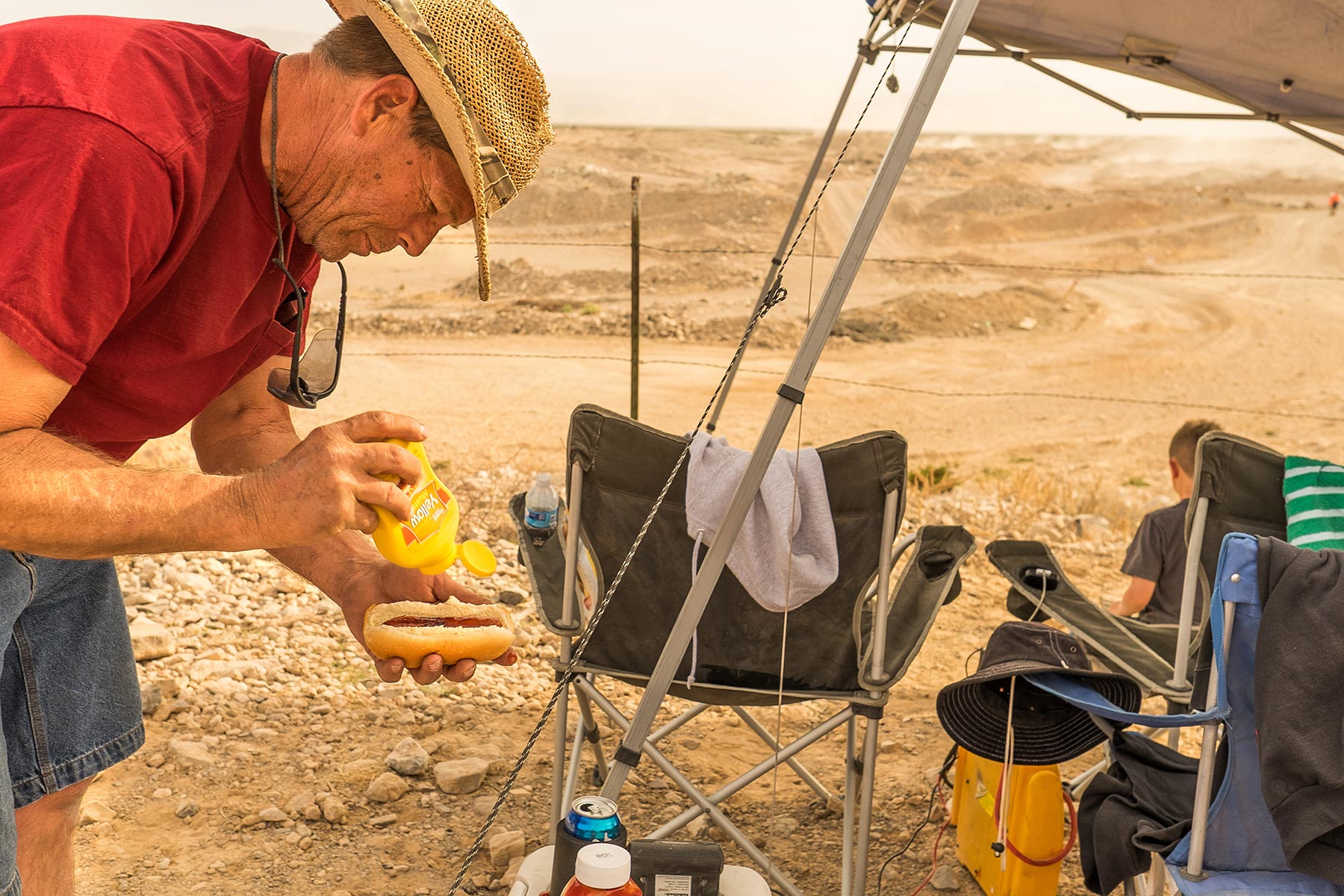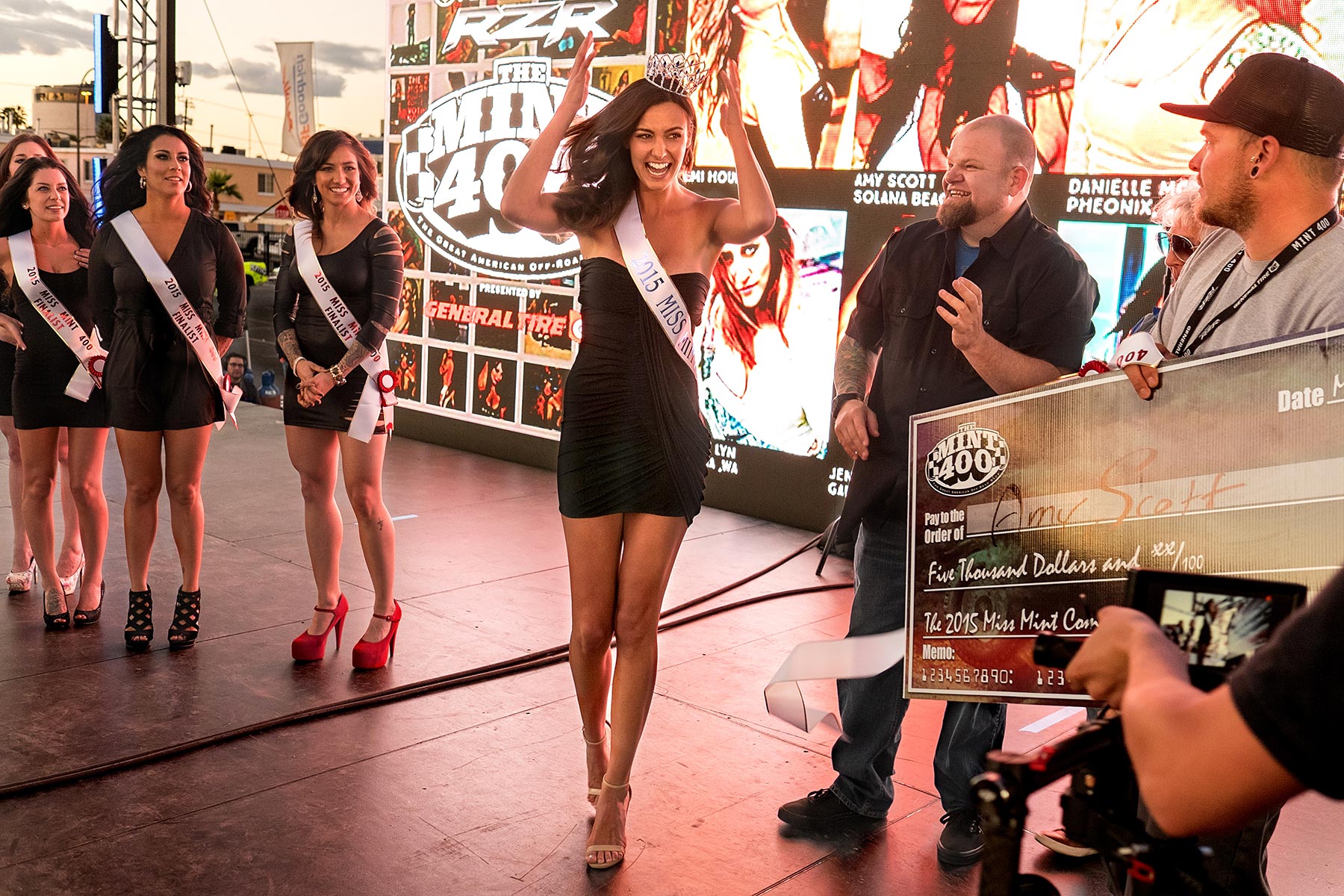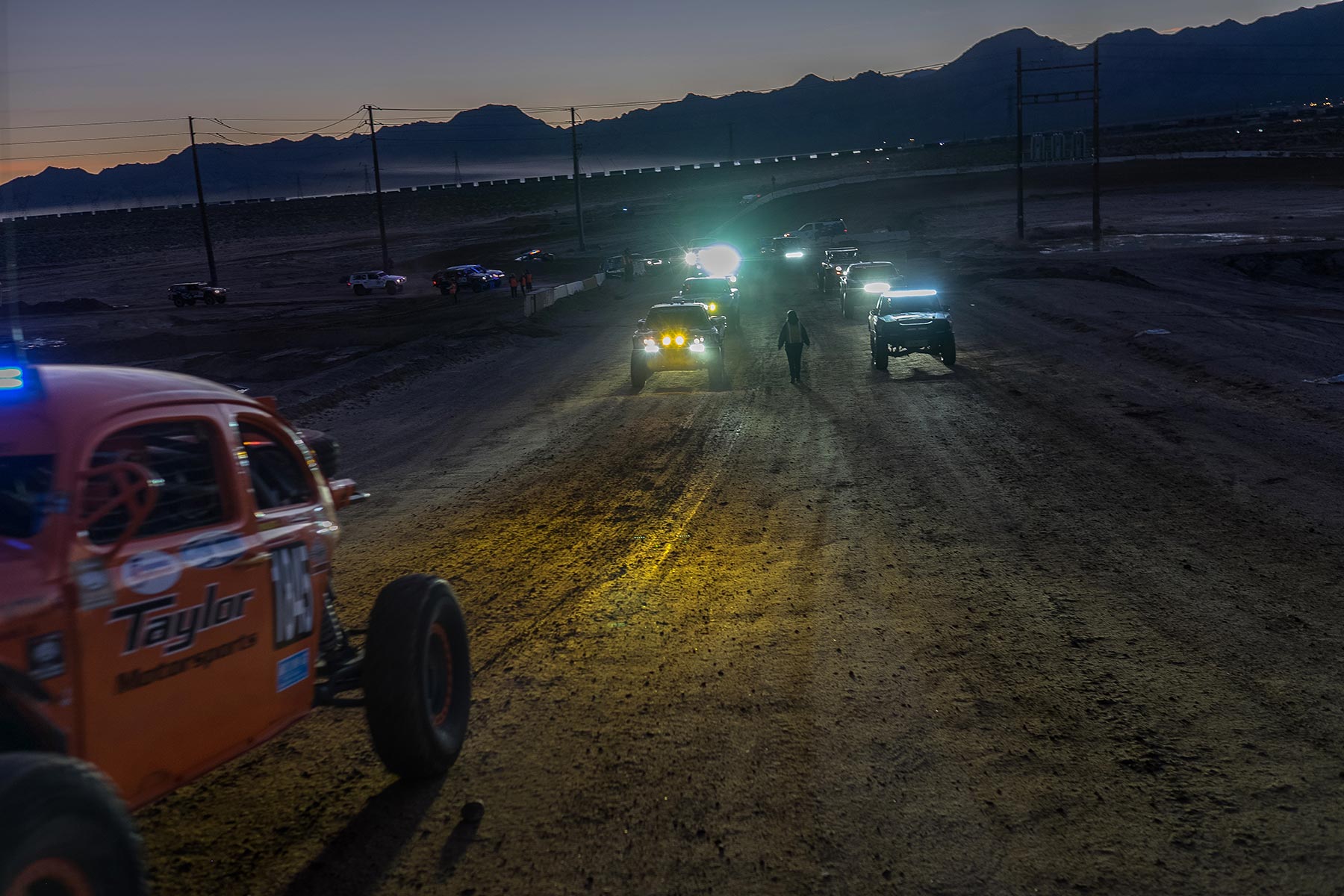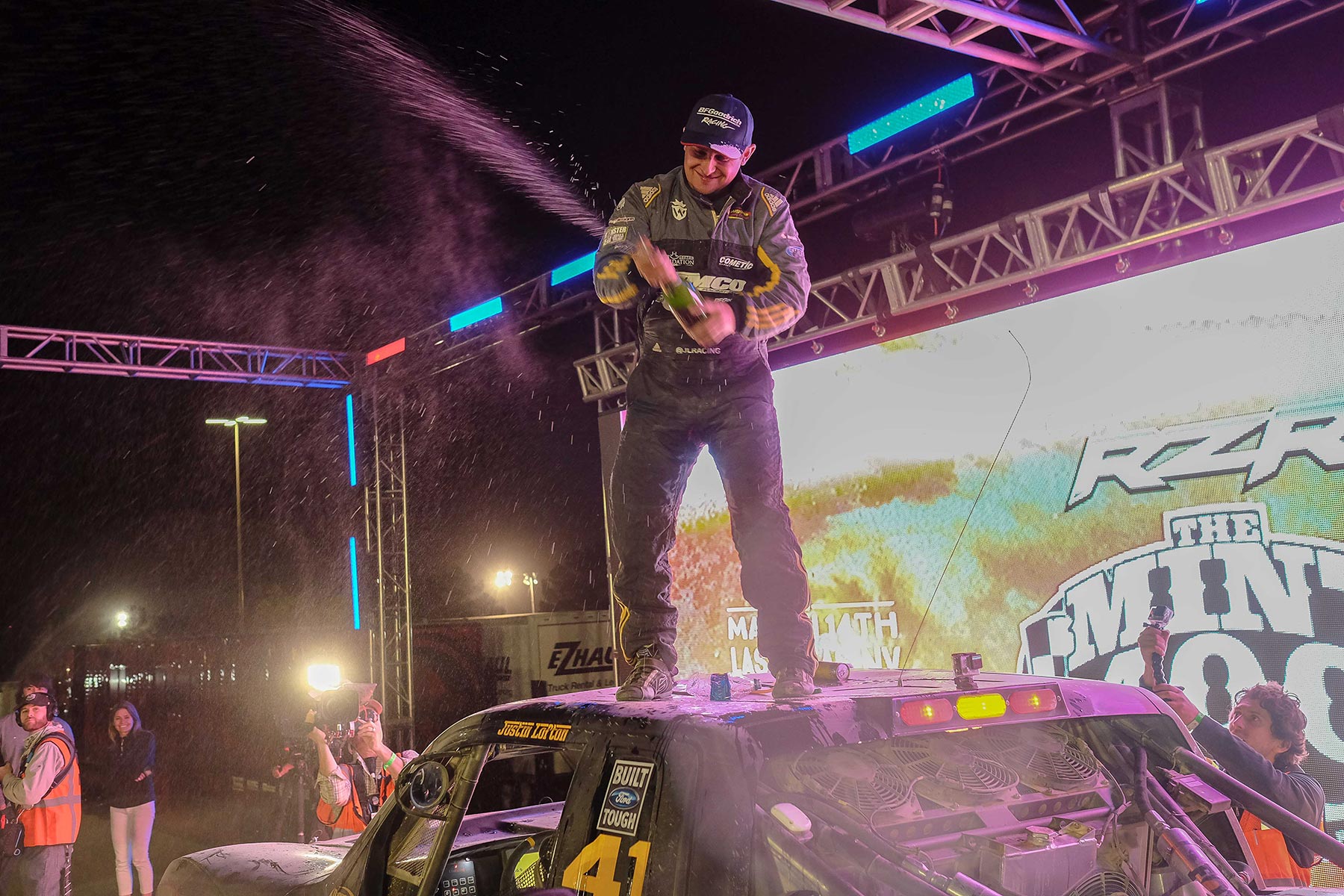
Dust and Diesel in the USA
The Mint 400 off-road race roars through the Mojave Desert
They carried welding equipment, spare tires, extra fuel, jacks, bottles of water, wrenches, zip ties, lawn chairs, engine oil, hammers, fire extinguishers, a grill, CB radio equipment, air guns and a generator. Guns N’ Roses played on the radio as the squad looked out into the khaki, sun-drenched desert, awaiting a blue dune buggy in need of fuel — one of 78 vehicles signed up with the Baja Pits, a freelance pit crew servicing all comers in the 28th Mint 400, one of the toughest off-road races in the world.
“For all intents and purposes, we’re a mercenary crew,” said John Ingold, a mechanic with Baja Pits. “You have money? We’ll pit for you.”
If you don’t have money, it’s likely they’d still pit for you.
Hailing from Inland Empire, California, the ragtag band consisted of a welder, an ex-Marine, a high school math teacher, a mechanic with a gravity-defying mohawk, an ex-Navy man and a logistics specialist with a penchant for Four Loko, a caffeinated beverage with high alcohol content. They were all volunteers, and they would help anyone who needed it.
Travis Vallo is a welder with the Baja Pits. Last year he spent two hours under just one car, pulling the vehicle back together. The driver was a wounded veteran.
“His team gave up on him,’’ Vallo said. “His team said ‘No, we’re done.’”
So Vallo went down and grabbed the truck, telling the vet “Bring it to us and I’ll weld it.’’
And he did.
The Mint was underway: 330 vehicles cleaving a path through 400 miles of the Mojave Desert for the chance to win $10,000 and big bragging rights. It’s held each year just south of Las Vegas, and fewer than half the competitors finish the race, because of wrecks, mechanical failures or, in some cases, fatigue.
“With off-road racing, once you leave that sideline, you’re committed,” said Rob Black, pit captain of the Baja Pits. “There’s not a safety crew on every corner. You’re out there on your own.”
The Mint 400 is one of the best-known off-road races in the literary and journalism world, after Hunter S. Thompson went to cover the event in 1971 and left with the beginnings of a book, “Fear and Loathing in Las Vegas”.
When Thompson went to the Mint, he stayed only briefly, then drove to Las Vegas in search of the American dream, fueled by drugs and rage. Had he stayed in the desert and finished the race, he may not have found that mainline to the American ethos, but he would have at least caught a glimpse of the American soul: For competitors, the race is more to do with conquest than triumph, as control over nature has been the American story from Plymouth Rock to the Mojave Desert.
In other words, there is nothing more American than driving a half-million-dollar, diesel-guzzling, off-road truck through the desert at ridiculously high speeds in the hopes of winning a small cash prize and a year’s worth of bragging rights.
Volkswagen Beetles flew through the air, only to come crashing back to earth with a tooth-busting bang. UTVs bounced as nimbly as water striders as they hurtled through the desert. A pack of Jeeps went screaming across the horizon, sending brown and gold dust plumes into the clear blue sky. Suddenly a blue dune buggy came howling out of the desert kicking up dust and diesel fumes and skidded to a halt at Black’s feet.
“How you guys feeling?” yelled Black as he approached the car.
“All right,” replied the driver.
“Need some water?” asked Black.
“We need some water,” said the driver.
“Let’s get some water!” yelled Black to his crew.
The driver climbed out the window of his doorless vehicle and took the opportunity to go to the bathroom. In a matter of minutes, the Baja Pits crew checked oil, inspected the car’s steering system and engine components and filled the tank. The driver climbed back in, kicked on the engine and bolted back into the desert, the car bouncing and jerking like a drunken hyena.
To get a sense of the Mint 400, imagine Mad Max, stir in NASCAR, throw in the spectacle of a monster truck rally and a pinch of Burning Man.
The thrill of off-road racing may be lost to many. Car manufacturers have worked long and hard to build vehicles that give the smoothest ride possible to consumers. Yet at the Mint 400, the more rugged the course the better. If you like your sports to challenge your intestinal fortitude, if you like thundering through the American outback with a horde of dust-covered dune buggies like a grunt in the Hun army, then this is the pastime for you.
“It’s man and machine against the elements,” said K.J. Howe, a former Mint 400 official and an elder statesman of the event. “The man behind the machine has to be able to understand the elements, and he has to understand his machine.”
Dust and traffic are a sure thing at the Mint 400. In some cases it’s almost impossible for drivers to see where they’re going because of the dust, but they continue at 90 miles an hour. When the race began in 1967, motorcycles were allowed, but by the 1970s, organizers barred them for a number of reasons, the most practical being that in a heavy dust cloud, it’s hard to know whether the big bump you just hit was a large rock or a motorcyclist who had fallen off his bike.
Competitors drive Volkswagen Bugs, Jeeps, Fords, UTVs and dune buggies. All have been hacked to pieces, then reassembled to be stronger, faster and meaner. Instead of purring, their engines growl. Instead of hood ornaments or bumper stickers, they sport roll bars, whip antennas, safety nets and massive grilles to guard against impact or to bump slower vehicles.
Drivers and co-drivers look like astronauts from a 1970s sci-fi movie, complete with jumpsuits in an array of muted colors and oxygen-fed helmets.
Instead of Champagne and caviar in Monte Carlo, like the race’s more respectable cousin, Formula 1, it’s beer and dirt on the outskirts of Las Vegas. Instead of pristine racecars flying around manicured tracks, it’s snarling beasts galloping over craggy hills and rocky dunes through thick veils of brown dust.
On the sidelines, spectators drink beer, grill hot dogs and hamburgers, smoke e-cigarettes and real cigarettes and apply suntan lotion through the day. Many are former racers, others are off-road enthusiasts, and still others come out of curiosity.
But don’t let the working-class spectacle fool you: Competing in off-road race is a ridiculously expensive endeavor.
For one, cars are expensive. Most people can’t afford to invest money in a vehicle just to beat it into scrap metal after a race or two. To get into competition requires a team of about 20 people, on average, including the driver, a co-driver, occasional replacement drivers, pit crews (mechanics, welders, supervisors and other assorted characters) and various support staffers.
“At the top level, you have the trick trucks or the trophy trucks that are half-a-million dollar custom builds and cost a million dollars a year to race,” said Matt Martelli, CEO of the Mint 400. “It just shows you that people want to come and race and are willing to do it and willing to absorb the cost to have the experience.”
For those hoping to win the Mint 400, a $10,000 cash prize awaits the fastest driver — pocket change compared with what it costs to compete. However, in the world of off-road racing, the bragging rights are worth their weight in desert dirt and shredded tires.
“It’s a 130-mile loop, and they go around that loop three times,” said Martelli. “Getting around that loop once is difficult, but then when you put 150 to 170 vehicles which race in each class all out there at the same time, it’s incredible.”
Besides the Mint 400, the Mojave Desert is home to the desert tortoise. Living up to 80 years and growing up to 15 pounds, it is listed as threatened, and a race like this can wreak havoc on its habitat.
“All week leading up to the event, we had biologists out there on the ground driving the course and checking known [tortoise] locations,” said Chris Linehan, an outdoor recreation planner with the Bureau of Land Management. “We put up temporary holding pens around them so they wouldn’t get out and wander on to the course.”
How to balance conservation with recreation and development has long been debated in America, but in this case it feels absurd that a race as decadent as the Mint 400 cuts right through the home of an threatened species that has absolutely zero ability to outrun a Volkswagen Bug crashing its way through the desert.
If you like risking danger in the form of a car accident for a shot of adrenaline, than this is definitely the sport for you. Mint 400 safety standards dictate that drivers make their vehicles as safe as possible. That means safety nets, roll bars and heavy-duty seat belts for the vehicles and helmets, fireproof suits and other gear for the drivers.
“In the day, we didn’t have nets,” recalled Howe. “A guy would roll over, he’d put his hand out, and he’d lose his hand.”
Compared with those early days — the days when drivers looked better equipped to fly a World War I–era Sopwith Camel bi-plane than drive a race car — advances in safety have come a long way.
After a vehicle leaves the starting line, competitors must finish or go home with their heads hung low. Mint 400 rules state that racers cannot get help on course should they have problems. If a tire goes flat, drivers have to change it. If an axle breaks, contestants have to find a way to get to the next pit stop or quit.
Those who have to quit can wait hours in the desert before getting towed out. Those who find their way to a pit have a team waiting and, hopefully, a fix to get them back out on course.
From the early-morning hours before sunrise to the blistering heat of the afternoon to dusk and beyond, racers must endure and drive.
It was nearly midnight, and a gas-powered generator hummed as the Baja Pits crew cooked sausages and waited for their last vehicles to come through. Their giant spotlights created a pool of light in the desert darkness, drawing giant moths and bats from the night.
“Those lights bring out the bugs, and the bats have a feast,” said Tony Navarrete as he looked up into the sky.
It was definitely bat country.
“Look at Tony’s jacket!” Travis Vallo yelled. “Turn around!”
“Holy shit!” exclaimed John Ingold, his mohawk still in perfect shape, despite nearly 24 hours on the job. “Turn around!”
Navarrete turned and looked over his shoulder to find a dozen giant moths on the back of his brown denim jacket.
“You’ve got the mom and all the cousins on there, Tony,” Vallo said, laughing.
“It looks like you’re transporting wombats,” said Ingold.
Over an hour earlier, Justin Lofton was crowned the winner of the Mint 400, but there were still dozens of racers making their way along the course. In the distance, headlights leaped out of the darkness and ricocheted against mountains, only to disappear behind bends and dunes.
A truck pulled in, and the crew went to work. Racers Brian Kirby and Leon Dunn had 27 miles to go before crossing the finish line, but they were leaking oil and would need repairs before going any farther.
“We’ve been sitting out in the desert freezing our asses off in the car for, like, three hours,” said Kirby as he watched the crew work on his vehicle.
“The sun was still up when we broke,” added Dunn. “But when the sun went down, we started freezing.”
The two men hail from Ontario, California, and raced the Mint before. Were it not for a faulty alternator, there’s no telling how the two would have finished. What mattered most now was that they do finish.
“You’re not going to find any more adrenaline than this, period,” said Kirby as he looked at his vehicle. “That trophy truck’s got 900 horsepower. There’s not a Lamborghini, there’s not a Corvette that can match that. You want to go do a doughnut in a parking lot? I don’t give a shit.”
Baja Pits finished its work, reattached the vehicles panels, stuffed the two men back into the car and helped them put their helmets on and get buckled in. Kirby and Dunn had 27 miles left, and they were determined to make it.
“Pullin’ the trucks!” a Baja Pits crewmember yelled.
“Trucks are out!” hollered someone else.
“Clear back here!” a voice bellowed from behind the vehicle.
“Clear!” came a reply.
“Clear!” echoed another.
“Light it!” someone screamed.
The engine erupted. The crew took a step back from the rumbling vehicle. Kirby punched the gas. A loud roar came from the engine, and the vehicle shot out of the pit and into the desert like an angry hornet as the band of mechanics watched.
“That’s what we do,” said Ingold as the cars taillights disappeared into the night.
“You gotta keep going,” said Rob Black. “If you’re hurt, your body hurts, your head hurts, you’re tired, you just keep going. That’s what it’s all about — finishing.”
In the distance another engine brayed; its call was answered somewhere in the night by another, then another, summoning the racers to the finish line and off the desert stage until the next year, when another crop of wealthy racers could go blasting through the desert, high on adrenaline and diesel, avoiding rocks and endangered desert tortoises for the title of Mint 400 winner.
